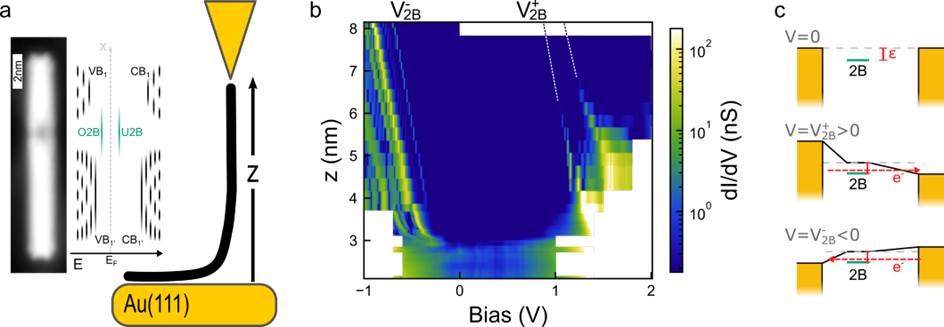Contributed talk
Bipolar Resonant Transport Through Spin States in a Free-Standing Graphene Nanoribbon
Niklas Friedrich1, J. Li1,2, I. Pozo3, D. Peña3 and JI. Pascual1,4
1 CIC nanoGUNE-BRTA, 20018 Donostia-San Sebastián, Spain
2 School of Physics, Sun Yat-sen University, Guangzhou 510275, China
3 CIQUS Centro Singular de Investigación en Química Biolóxica e Materiais Moleculares, 15705 Santiago de Compostela, Spain
4 Ikerbasque, Basque Foundation for Science, 48013 Bilbao, Spain
Coherent electron transport through individual molecules is a vital technique to probe different quantum mechanical properties like energy level alignment, vibronic modes or spin states. Here, we investigate the electronic transport through 7-armchair graphene nanoribbons (GNRs) containing a single, substitutionally embedded 2B-dimer. The 2B-dimer creates a topologically protected in-gap state inside the ribbon [1]. We find that the coherent electron transport through the 2B-GNR is bipolar with the singly occupied 2B-state (O2B) enabling resonant electron tunneling at either voltage polarity. The bipolar transport is favored by the exponential localization of the O2B around the 2B-dimer resulting in a double tunneling barrier configuration. We observe satellite peaks next to the main transport resonance corresponding to vibronic modes εv=20 meV. Further transport resonances reveal that resonant transport through the valence band (VB) exhibits a bipolar character, too, and shows fingerprints of band quantization in form of Fabry-Perot quantum well modes in our experiments. The experiments were performed by lifting single 2B-GNRs using the tip of a low-temperature scanning tunneling microscope (STM) to create the molecular wires that bridges tip and substrate. Our results unravel the details of coherent resonant electron tunneling through molecular wires built from single 2B-doped GNRs, confirming their technological potential for single molecule electronics.
 Figure 1: a STM image of a 2B-GNR together with the real-space visualization of its bandstructure. The sketch indicates the experimental setup. b Colormap of -spectra recorded at different z with the 2B-GNR suspended in the tip-substrate junction. c Sketch of the energy level alignment at zero bias and for resonant transport at both polarities.
Figure 1: a STM image of a 2B-GNR together with the real-space visualization of its bandstructure. The sketch indicates the experimental setup. b Colormap of -spectra recorded at different z with the 2B-GNR suspended in the tip-substrate junction. c Sketch of the energy level alignment at zero bias and for resonant transport at both polarities.
[1] N. Friedrich, P. Brandimarte et al., Phys. Rev. Lett. 125, 146801 (2020)